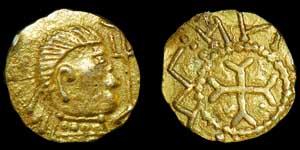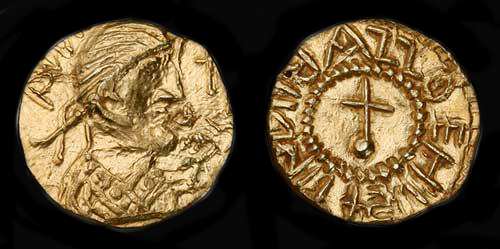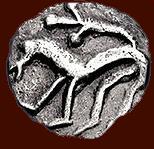








Designed by Nigel G Wilcox






The Paragon Of Metal Detecting
& Archaeology
& Archaeology
Powered By Sispro1
Anglo-Saxon & Viking A.D. - Currency Numismatics,
Thrymsa
For Reference ONLY
Everything For The Detectorist
Thrymsa
Copyright All Rights Reserved by Nigel G Wilcox E-Mail: ngwilcox100@gmail.com
Viking Menu
Viking Timeline
Anglo-Saxon Timeline
1.
Eadbald 620-625 AD
1. Kent (Canterbury?). Obv: profile diademed bust right with three ties and trident before. Rev: cross fourchee with blundered legend. S. 753; N. 25; Sutherland IV.ii; M (1). 21, Gold, 1.24 grams.
Very fine, small striking split at 9 o'clock and minor scuffs to cheek and eye, struck off centre, extremely rare (9th known die specimen, most in museums).
Found near Sandwich, Kent, 2011; recorded Early Medieval Corpus and UK Finds Database Reference No. 33730.
The Crondall group comprises twelve English gold shilling (thrymsa) types represented in the famous Crondall, Hampshire, 1828 hoard (ex Lord Grantley collection and now preserved intact in the Ashmolean Museum, Oxford). The 'Witmen' type is named from those with the WITMEN MONITA legend and this is usually seen blundered or in abbreviated forms. The type was almost certainly struck in Kent, possibly at Canterbury.
2. July 22nd, 2010 - On June 24th, 2010 Spink sold an Anglo-Saxon gold Shilling of King Eadbald of Kent dating from c.620-635 for 30.000 Pounds to a private collector. This Shilling is the first gold coin struck in the name of an English King and a rare and important piece of English history. It was found near Deal Kent in 2010.
This type of coin was long known to be amongst the earliest of Anglo-Saxon gold coins with a single example present in the important Crondall hoard found in Hampshire in 1828 which was hidden c.670. However, the conclusive attribution of these coins to King Eadbald of Kent, who reigned from 616 to 640, was only made in 1998.
On the obverse avdvarld reges is written and is translated as 'of King Audvarld'. The name 'auduarldus' appears in Bede's Historia Ecclesiastica completed in 731 in which he wrote about king Eadbald of Kent. The reverse inscription is a corruption of the word londenv indicating London as the mint or die source for this coin.
Thrymsa's were the first native Anglo Saxon coinage to be produced in England. They are hammered coins, hand made by striking a blank between two dies, the method of coin making which persevered in this country from the first century BC to the 17th century.
With the departure of the Romans in the early fifth century supplies of coins soon dried up, and it is argued that no coins were circulated between the middle of the 5th century and the second half of the 6th century, when small quantities of Merovingian coins (tremisses) began to enter the country. In the late 6th century, coins based on tremisses were first produced in England. These gold thrymsas continued to be minted until around 675, when silver sceattas, essentially debased thrymsas, superseded them.
There are a number of different types of thrymsa, but all are very rare. As noted above, the first were based on the Merovingian tremissis, but others were based on Roman prototypes or were purely Anglo-Saxon in style with runic or meaningless Latin legends. It is thought that there were mints in London and Kent, and possibly York. Wuneetton type thrymsas are thought to be derived from Witmen type thrymsas, and are mainly found, and presumably minted, around London and Kent. Names 'Wunetton' and 'Witmen' come from the coins' Latin legends, perhaps personal names, sometimes blundered and including runes. The Crondall hoard was discovered in 1828 and provides the main source of information on these thrymsas. The hoard is dated to AD 620 - 630's and contained Witmen type but not Wunetton type thrymsas. This and stylistic and metallurgical grounds indicate a date of c 650 for Wunetton type thrymsas. There are only six other recorded Wunetton type thrymsa s and this example is particularly exciting, being the furthest West yet found and of a unique sub-type. Gareth Williams of the British Museum has stated that 'the pellets in the angle of the cross on the reverse represent a sub-type which to the best of my knowledge is otherwise unknown'. It is the only known Thrymsa from Gloucestershire.
Very fine, small striking split at 9 o'clock and minor scuffs to cheek and eye, struck off centre, extremely rare (9th known die specimen, most in museums).
Found near Sandwich, Kent, 2011; recorded Early Medieval Corpus and UK Finds Database Reference No. 33730.
The Crondall group comprises twelve English gold shilling (thrymsa) types represented in the famous Crondall, Hampshire, 1828 hoard (ex Lord Grantley collection and now preserved intact in the Ashmolean Museum, Oxford). The 'Witmen' type is named from those with the WITMEN MONITA legend and this is usually seen blundered or in abbreviated forms. The type was almost certainly struck in Kent, possibly at Canterbury.
2. July 22nd, 2010 - On June 24th, 2010 Spink sold an Anglo-Saxon gold Shilling of King Eadbald of Kent dating from c.620-635 for 30.000 Pounds to a private collector. This Shilling is the first gold coin struck in the name of an English King and a rare and important piece of English history. It was found near Deal Kent in 2010.
This type of coin was long known to be amongst the earliest of Anglo-Saxon gold coins with a single example present in the important Crondall hoard found in Hampshire in 1828 which was hidden c.670. However, the conclusive attribution of these coins to King Eadbald of Kent, who reigned from 616 to 640, was only made in 1998.
On the obverse avdvarld reges is written and is translated as 'of King Audvarld'. The name 'auduarldus' appears in Bede's Historia Ecclesiastica completed in 731 in which he wrote about king Eadbald of Kent. The reverse inscription is a corruption of the word londenv indicating London as the mint or die source for this coin.
Thrymsa's were the first native Anglo Saxon coinage to be produced in England. They are hammered coins, hand made by striking a blank between two dies, the method of coin making which persevered in this country from the first century BC to the 17th century.
With the departure of the Romans in the early fifth century supplies of coins soon dried up, and it is argued that no coins were circulated between the middle of the 5th century and the second half of the 6th century, when small quantities of Merovingian coins (tremisses) began to enter the country. In the late 6th century, coins based on tremisses were first produced in England. These gold thrymsas continued to be minted until around 675, when silver sceattas, essentially debased thrymsas, superseded them.
There are a number of different types of thrymsa, but all are very rare. As noted above, the first were based on the Merovingian tremissis, but others were based on Roman prototypes or were purely Anglo-Saxon in style with runic or meaningless Latin legends. It is thought that there were mints in London and Kent, and possibly York. Wuneetton type thrymsas are thought to be derived from Witmen type thrymsas, and are mainly found, and presumably minted, around London and Kent. Names 'Wunetton' and 'Witmen' come from the coins' Latin legends, perhaps personal names, sometimes blundered and including runes. The Crondall hoard was discovered in 1828 and provides the main source of information on these thrymsas. The hoard is dated to AD 620 - 630's and contained Witmen type but not Wunetton type thrymsas. This and stylistic and metallurgical grounds indicate a date of c 650 for Wunetton type thrymsas. There are only six other recorded Wunetton type thrymsa s and this example is particularly exciting, being the furthest West yet found and of a unique sub-type. Gareth Williams of the British Museum has stated that 'the pellets in the angle of the cross on the reverse represent a sub-type which to the best of my knowledge is otherwise unknown'. It is the only known Thrymsa from Gloucestershire.
| 1.. Estimated value: 4,200 |
2.


| 2.. Estimated value: 30,000 |
Pages
Main Coin Menu
Anglo-Saxon
Menu
Menu
Member NCMD
A.S. Menu
Information Data
See Frederick II 620-625 AD
See Eadbald 620-625 AD
Valentinian I 364-375 AD
Gratian 267-383 AD
Magnus Maximus 383-388 AD
Valentinian I 364-375 AD
Gratian 267-383 AD
Magnus Maximus 383-388 AD
























